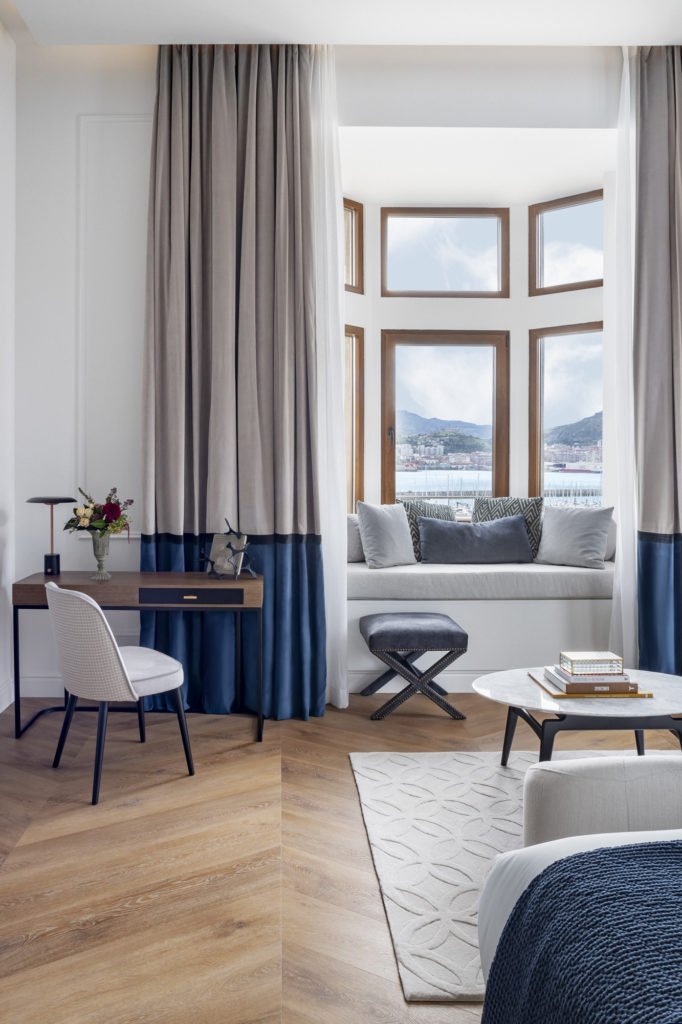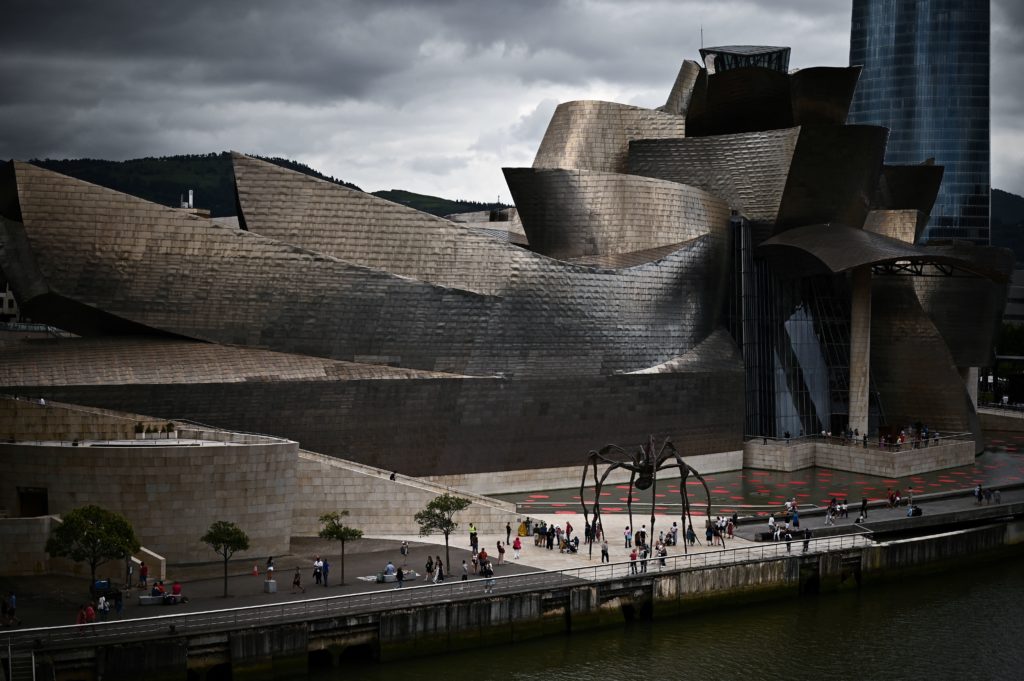MAL ROGERS heads for northern Spain
Ah, Spain! Flamenco, furnace heat, siestas, fiestas, tapas, vino tinto — and prawns without the cocktail.
Er, not so fast. Wine yes, tapas, prawns, yes. And fiestas too — no matter where you go in Spain there appears to be a party going on, usually to mark some saint’s holiday. To paraphrase the historian and writer Jonathan Meades, Spain’s calendars is littered with days for shirking work in the name of Christianity.
In the Basque country the ethos of fiesta is very pronounced, but there’s not so much of the flamenco or the furnace heat. For this is Green Spain, where the skies often mean mischief, the landscape rolls gently down to the Bay of Biscay, and the countryside is as verdant as the plains of Kildare.
My destination in this part of España Verde was Getxo, a renowned gastro centre. The town has innumerable bars offering a huge range of pintxos — basically jumped up tapas. In Getxo’s famous Old Port, restaurants specialising in every type of fish and seafood are mixed with traditional Basque recipes.
The town, squeezed in between cliffs and skirted by the majestic Nervión River, overlooks the southern waters of the Bay of Biscay. My taxi driver, a perfectly friendly chap, spoke no English, and seemed very reluctant to speak Spanish — or at least my version of Castilian. Maybe it’s a Basque thing, At any rate I sensed that we wouldn’t be singing ¡Viva España! by the time we reached our destination. The journey was largely in silence, so I didn’t get much of a bearing on the buildings, monuments, parks we passed en route.
I was booked in to the Palacio Arriluce Hotel, newly opened earlier this year. First impressions were excellent. Housed in a meticulously refurbished early 20th-century palace, the hotel looks out over the bay, northwards towards France, westwards towards America.
The four-year-long project to convert the place, managed by Hotelab Hotel Consultancy, seems to have gone very well. The rooms are as big as meadows, and exquisitely designed.
 The Marina Suite
The Marina SuiteAt the check-in the receptionist told me that additional amenities include a fully equipped gym — which I was determined, I told her, not to visit; an on-demand spa offering exclusive treatments (I thought I might give that a go); an outdoor swimming pool with pool bar La Ría (ditto about giving it a go) and an “an approved croquet court”. An approved croquet court. Eh? Anyway, croquet’s not really my thing, so I’ll leave that one with you if you decide to go.
The Palacio is the sort of hotel that is a destination in its own right, but you will undoubtedly, at some point, want to head out along the coast, or into Bilbao. Probably.
 Bar inglés Palacio Arriluce Hotel
Bar inglés Palacio Arriluce HotelBut before setting off from the Palacio I needed an immense lunch in order to function more efficiently and make the most of the afternoon.
So I headed to the hotel’s cocktail bar the Kupka located within the former chapel and library of the palace.
I ordered up a Cuba Libre cocktail of cola, lime juice, rum and a topping of ice to keep it all cool – perfect with the pintxos — red pepper stuffed with tuna and olives on a flat bread, and something called marmitako which turned out to be a puréed Basque fish stew. My bouche was seldom more amuséed.
I finished off with a couple of glasses of the local red, Bizkaiko, made in the vineyards around the city of Bilbao. Probably passed them on the way from the airport, although my driver, predictably, made no mention. The wine was a 2015 Itsamendi from the D.O. Bizkaiko Txakolina, and a couple of glasses went down very smoothly.
I suppose, I thought to myself, I didn’t need to go in to Bilbao to see the Guggenheim just yet. I could go back up to my room, enjoy the view, maybe write some poetry.
 The Guggenheim Bilbao (Getty Images)
The Guggenheim Bilbao (Getty Images)The buildings of Bilbao
The next day, it was serious sightseeing. So, all aboard the Feve coastal train. This narrow gauge rail service threads its way from Bilbao through Santander and Oviedo to León. It skirts cliff tops, plunges through tunnels, and rushes alongside beaches. No need to book — hop off and on at one of the many stops en route.
Or you could opt for the Transcantábrico, with luxury dining and sleeping on board. As they say, it’s your right to choo choos (a small play on words, which doesn’t translate well into Spanish).
The pilgrims, of course, can’t use the train. They have to stick to the Camino de Santiago de Compostelo — Bilbao is on the Camino del Norte, along with ancient villages such as San Vincent de la Barquero. This was once home to the local Inquisitor (a definite no to the Monty Python routine —locally, they’ve never heard of Michael Palin). But history spills out of Spain’s attic here; they’ve always taken their Christianity seriously in San Vincent: in 1275 fishing boats gathered here to sail south to help in the Reconquest of Spain.
Further down the coast is Comillas, and if you want to see some Gaudi architecture at first hand without all the crowds of La Sagrada Familia in Barcelona, head for El Capricho de Gaudi. It’s all there in this astonishing house – an extreme of artifice which includes sash windows that ring bells when they open, a bird playing a piano, a bee playing a guitar. What was this guy on?
The next day it was off to the Guggenheim Bilbao some 10km from the Palacio Arriluce Hotel. Bilbao, in case it had escaped your notice, is a global art destination.
If you’ve arrived by plane, you’ll already have marvelled at the design of the airport, perhaps the most stylish in Europe. Santiago Calatrava’s design is what you might call architectural exuberance. But that’s only for starters. Because this Basque city is also home to what is reckoned to be one of the most photographed buildings in the world —certainly over the last few decades: the Guggenheim Bilbao. Frank Gehry’s titanium waves that make up the exterior — giving some sort of resonance with Bilbao’s industrial past — might be called irrational draughtsmanship. But let me tell you: it is spectacular, and has come to represent Bilbao’s transformation from industrial epicentre to European art central.
The Guggenheim has made both its architect, the Canadian Gehry, and the Basque city world famous. It is the mother and father of all strange looking constructions the world over. Basically this is show-off, jack-the-lad architecture. And it truly is wonderful.
The museum houses an equally impressive art collection with extensive Basque influence. Internationally acclaimed artists grace the museum's galleries, contributing to its reputation as a global cultural hotspot.
But it was time for dinner, and I headed back to the Palacio Arriluce Hotel. The Dealuney Restaurant promised quite the gastronomic experience from a menu curated by the award-winning Beñat Ormaetxea. He takes an innovative approach to the traditional flavours of the Basque region, and they are many and varied.
The menu lives up to its word — my advice: start with lobster salad, green apple tartare and Modena vinegar. Finish with the torrija of brioche bread and local Basque ice cream ice cream, Try not to think about the bill. And watch the sun set over the Bay of Biscay.

